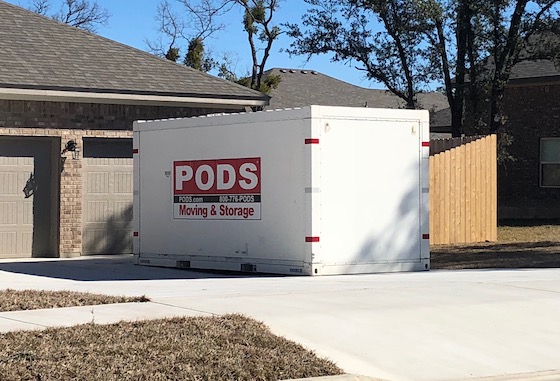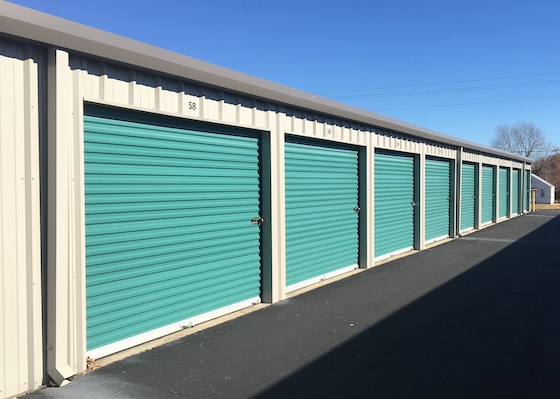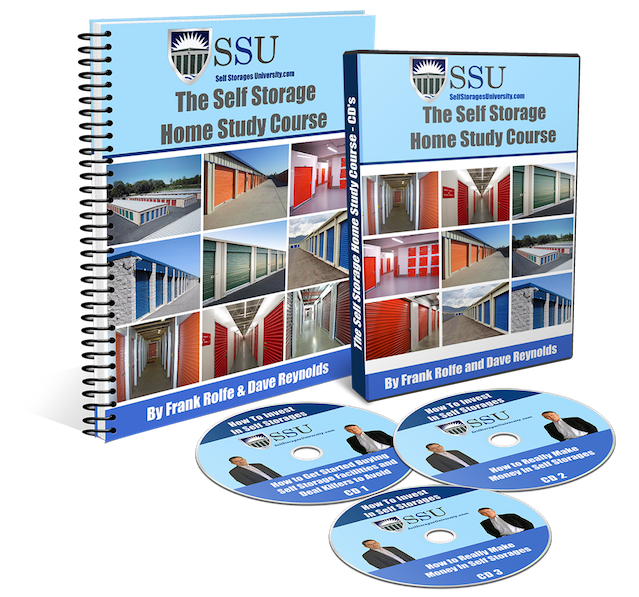“Spring cleaning” is the annual concept that frees most American homes and garages of excess inventory – the materialism assembled over the past. So where does it go? Statistics show that a good amount of this merchandise goes into self-storage facilities. So perhaps March 20th – the official start of Spring – should also be declared National Self-Storage Day. And on that note, it’s also important to get your storage property off on the right foot starting now. That would include general property clean up – painting buildings, fixing potholes, planting seasonal color, etc. The faster you move the better, as warmer temperatures will definitely bring about greater consumer activity and advance thinking of which storage facility is the most attractive. So get your game on, because the prime time for 2019 is here!
Memo From Frank & Dave
Can You Compete With Storage Providers That Pick Up And Deliver?

We’ve all seen the familiar sight of PODS in a driveway in front of a garage. This is the storage alternative in which they come to our house and pick up your stuff, and then deliver it back when you request it. The question is: will this business model ultimately replace the traditional self-storage business? We don’t think so for several compelling reasons.
Convenience
The average consumer wants to be able to access their storage 24/7. With the pick-up-and-deliver business model, the customer is restricted to pre-arranged storage access. While there certainly is an application for this when moving entire home contents into storage, it’s not what the average American wants in their storage unit.
Cost
It’s obviously more expensive to use a pick-up-and-deliver service as opposed to do-it-yourself. That’s true in all things in life. However, since most Americans feel guilty storing their material possessions to begin with, it’s unlikely they want to amplify that cost in their budget. It’s the difference between flying first class and coach.
Perceived security
No offense to the PODS business model, but we personally don’t feel totally safe with letting our stuff be moved around out of your sight. It’s just a trust issue, but one that many Americans we think would share. What if your container becomes lost? What if somebody breaks into it at the warehouse? When you use the traditional model, you personally know it’s there because you placed it, and you know it’s secured by a masonry or metal building with metal roll-up door further secured by a lock and security cameras.
Conclusion
The traditional form of self-storage is exactly what most American consumers want. However, there is also room in the giant storage spectrum for the pick-up-and-deliver model. They can happily co-exist. But there’s little likelihood that one will ultimately wipe out the other.
Self Storage Home Study Course
Our Home Study Course is not like anything you have ever listened to or read before. We do not fill it with a bunch of fluff on how your are going to make a million bucks with no money down. We tell you the whole story... the good, the bad, and the sometimes ugly.
Click Here for more information.
How Do You Get Their Business?

Every day in America, roughly 14,027 homes change hands. And with that move often comes an immediate move for self-storage to house the overflow. So how do you tap into these newcomers and close the deal as their storage provider?
Old-fashioned methods vs. modern technologies
Although we’re becoming more of an internet nation, that does not mean that the old methods no longer work. Instead, smart storage owners utilize both old-fashioned and modern methods to attract customers simultaneously. On interesting statistic today is that modern technology typically attracts 75% of potential customers, while old-fashioned methods create 25% of leads. However, of those potential customers, the old methods close roughly 75% of visitors, while new methods only close around 25%. That means that both methods have about equal results when it comes to actual leases signed.
Old-fashioned concepts
So what are these old-fashioned methods and how do they work?
- Property sign. This is your main sign along the frontage. It needs to be large, easy to read, and attention-getting. Well-lit is another benefit.
- Banners. These are large additional ad messages that can be easily seen from the road and are in the form of writing on long lengths of vinyl. They can advertise such things as move-in specials.
- Feather flags. These are the latest trend in flags, which have replaced traditional models that require wind to stand out. They are brightly colored and can also contain ad messages.
- Direct mail. These are postcards or letters that are sent out in large volume with the goal that the customer will read your offering and call you.
- Property appearance. Nobody wants to patronize a filthy storage center – it suggests to the user that their belongings are not safe when they’re gone. Instead, all storage facilities should be nicely painted, mowed and landscaped.
- Well-marked office. Customers want to know where to go in order to rent a unit. Don’t make them hunt for it. Put up clear signage directing the customer to the office.
- Inviting office. Just as you want to have an inviting storage property from the road, you also want to make the office impressive.
- Well-trained staff. You can lead a horse to water but you can’t make them drink – that’s also true with self-storage. It is mandatory that you have a staff that is professional and gives the customer confidence in their decision.
New methods
The new methods of bringing in customers mostly did not exist until the advent of the internet, and then accelerates in recent times with the growth of social media.
- Google presence. You really can’t succeed as a storage owner without coming up on any search that says “self-storage in [name of your city]”. If you don’t populate that list, you’re literally off the radar screen for most customers.
- Attractive website. Once someone finds you on an internet search, they will click on your website. As a result, you have to field a terrific site that gives them the assurance that you are a good business.
- Google Adwords. These allow you to target specific search terms by the customers such as “self-storage”. As a result they are an extremely efficient way to hit customers and your results can be tracked.
- Craigslist.
- Other
Trust but verify
Despite the best marketing blitz in history, human error can destroy all your good work. So you never want to blindly trust that your staff is doing their job. You should relentlessly mystery shop your property by dialing *67 and then pretending to be a customer. You can also pay someone on Craigslist $50 to drop by and pretend to be a customer on site. You should request constant photos and videos of your property to make sure it’s being maintained well. And you can even go on a search out the fact that the correct ads are running and what they say. With so much at stake, you can’t go on without verification.
Conclusion
There is a science to bringing in customers. Successful storage owners employ these techniques every day. You should consult this list and see how you stack up.
How M.J. Vukovich Can Get You A Cash-Out Loan
Conduit debt (also known as CMBS debt) is a special product that offers 70% LTV on appraised value – regardless of what you paid for the storage facility. This means that if you have created value through greater net income, then you will be rewarded at refinancing with a higher valuation and, potentially, a “cash-out” situation. This means that you will effectively get all your down payment back from the original purchase, plus additional cash out based on the new effective value. And this “cash out” is tax free since it’s effectively a loan. In addition, these conduit loans are non-recourse and feature low, fixed interest rates and long loan terms. But how do you get one? If your deal is over $1 million, then the answer is using a loan broker, and the best in the business is M.J. Vukovich at Bellwether Capital. We’ve been using him for years and he essentially creates the loan request, meets with the lenders, helps you in the selection, negotiate the final terms and shepherds the deal to closing. In exchange he gets a small commission that is a bargain for the amount of time and expertise rendered. For more information call him at (612) 335-7740 or email him at [email protected]. You’ll be glad you did.
Mitigating The Reality Of Self-Storage Ownership Vs. The Fantasy

Everyone loves a “Disney ending”, but is that possible with the purchase and operation of a self-storage facility? It is if you mitigate the dangers to your goals and plan accordingly. So what are the methods to reduce your risk of having unhappy surprises or results with your storage investment?
Financial Realities
When you buy a storage property, you should run and re-run the numbers until you are confident you have a complete mastery of the financials. The worst stories I know of storage owners being unhappy begin with not really understanding what the realistic numbers would be. On top of that, you have to keep a constant eye on your financial performance after purchase. You should have rigid meetings monthly – even with only yourself – to compare your budget to the actual performance and the differential between the two. That’s the only way to make sure you stay on track, kind of like a financial performance GPS system. Finally, never buy a storage facility with overly optimistic assumptions on occupancy and rents. It’s OK to factor in ramping up revenue, but under-estimate the amount and timing rather than over-estimate.
Operational Realities
Once you buy the property, you still have to manage it effectively to succeed. The first step is to hire and train the right manager. Or, if it’s a smaller property, train yourself on how to rent units and collect rent. The manager is your quarterback, and no football team has ever won a championship with a bad one. Additionally, you have to understand the key drivers to profitability and never take your eye off those gauges, which include 1) collections 2) sales and rentals and 3) cost containment.
Capital Improvement Realities
Before you buy the facility, make sure that you have a firm handle on the property condition and the realistic cost to make necessary repairs and improvements. Typically when there’s a bank loan the property condition report is mandatory, but when you get mom & pop to seller finance, this important step is sometimes skipped and replaced with the buyer making a guess (which is also often manipulated by the seller). If you buy a property at a 10% cap rate for $1 million, then that cap rate is destroyed if you have to immediately pour $300,000 into fixing the roof.
Understanding Worst Case Scenarios
In every investment, you should build a matrix of “best case”, “realistic case” and “worst case”. The first two are fine, but you need to put extra attention on the latter. Most buyers, however, skip that scenario because it’s no fun. Don’t let that be you. We’re not talking the absolute “worst case” because that’s you driving into a truck head-on while going to the closing at the title company. What we’re talking about here is the understanding of the financial stress of not hitting budgets and if you can hold things steady in that event. If you can withstand the “worst-case” scenario, then your risk with the property is limited. For example, if you can still make the mortgage payment with a 20% decrease in revenue, then you can sleep pretty soundly. But you have to tailor make the worst case to the individual property and market.
Conclusion
There’s no reason why every storage investment can’t have a fairytale ending. But to make that possible, you have to do your homework and mitigate the risks.
The Most Important Lessons Learned In Finding A Storage Facility To Buy

If we were on a game show and it was a head-to-head competition to buy a successful self-storage unit, how would you organize your efforts? Well, based on over two decades of buying storage properties, here’s what we’d do.
Build a sorter
You can’t find the right property unless you can put them in two piles: 1) deals with the right raw material for success 2) deals with no potential for success. Until you can achieve that, you won’t get any where. You sorter may be a certain geography, deal size, cap rate, ability to obtain institutional debt – whatever the key factors are for you as a buyer.
Volume
Once you’ve built your sorter, then the whole key is to pour as many properties through it as you can. Take, for example, the gold miner. Once they build their sorting screen, they dump as much dirt into it as possible. The reason? Nothing is a substitute for raw volume. Those who look at 100 deals always do better than someone who looks at 10.
Be a deal maker – not a deal killer
It’s not enough just to look at potential purchases – you have to do so with the right attitude. We call this attitude being a “deal maker” and it requires the buyer to think about what would be required to make a deal a success, and then pitch that plan to the seller. This is the opposite of being a “deal killer”, in which the buyer looks at every deal with skepticism and never goes through the mental exercise of giving each deal due consideration.
Conclusion
We’ve been buying self-storage for over two decades. The basic steps have not changed in all that time. This methodology will get you off on the right foot.
Brought To You By SelfStoragesUniversity.com
If you need more information please call us (855) 879-2738 or Email [email protected]
